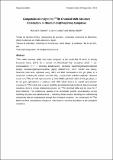Computational Insight into Rh-103 Chemical Shift-Structure Correlations in Rhodium Bis(phosphine) Complexes
Abstract
103RhNMR chemical shifts have been computed at the GIAO-B3LYP level of density functional theory (DFT) for a number of [Rh(COD)(P∩P)]+ complexes [COD = 1,5-cyclooctadiene, P∩P = chelating bis(phosphine) including bis(dimethylphosphino)ethane (dmpe), bis(diphenylphosphino)ethane (dmpe), MeDUPHOS, DIOP, BINAP, and others]. Structures have been optimized using PBE0 and M06 functionals in the gas phase, in a continuum modeling the solvent, and with [PF6]− counteranion included explicitly. Observed trends in δ(103Rh) are well reproduced for pristine PBE0-optimized cations in the gas phase or for ion pairs optimized in a continuum with M06. While there is no overall trend between computed δ(103Rh) values and complex stabilities (evaluated through isodesmic ligand exchange reactions), there is a linear relationship between the 103Rh chemical shifts and the mean Rh–P bond distances. This relationship appears to be remarkably general, encompassing various chelating ring sizes and substituents at P, including remote electron-donating and -withdrawing substituents that are characterized through their Hammett constants. The combination of 103Rh NMR and DFT computations emerges as a useful tool for structure elucidation of Rh–phosphine complexes.
Citation
Ortuno , M A , Castro , L & Buehl , M 2013 , ' Computational Insight into Rh-103 Chemical Shift-Structure Correlations in Rhodium Bis(phosphine) Complexes ' , Organometallics , vol. 32 , no. 21 , pp. 6437-6444 . https://doi.org/10.1021/om400774y
Publication
Organometallics
Status
Peer reviewed
ISSN
0276-7333Type
Journal article
Collections
Items in the St Andrews Research Repository are protected by copyright, with all rights reserved, unless otherwise indicated.
Related items
Showing items related by title, author, creator and subject.
-
Hydrothermal alteration and mineralisation of the Nigerian anorogenic ring complexes: with special reference to the Saiya Shokobo complex
Kinnaird, Judith Ann (University of St Andrews, 1987) - ThesisThe Nigerian anorogenic province is characterised by more than 50 complexes. In some complexes, the outer limits of the complexes are defined partly or completely by a ring dyke. This intrusion, generally composed of granite ... -
Using zircon in mafic migmatites to disentangle complex high-grade gneiss terrains – Terrane spotting in the Lewisian complex, NW Scotland
Fischer, Sebastian; Prave, Anthony; Johnson, Tim; Cawood, Peter Anthony; Hawkesworth, Chris; Horstwood, Matthew; EIMF (2021-04) - Journal articleThe zircon record of complex high-grade gneiss terrains is key to interpreting their tectonothermal evolution. Typically, such studies focus on zircon-rich, felsic rocks, which commonly have a complicated (partial melting, ... -
Versatile para-substituted pyridine lanthanide coordination complexes allow late stage tailoring of complex function
Starck, Matthieu; Fradgley, Jack; De Rosa, Davide F; Batsanov, Andrei; Papa, Maria; Taylor, Michael; Lovett, Janet; Lutter, Jacob; Allen, Matthew; Parker, David (2021-11-16) - Journal articleA series of cationic and neutral p-Br and p-NO2 pyridine substituted Eu(III) and Gd(III) coordination complexes serve as versatile synthetic intermediates. Nucleophilic aromatic substitution occurs readily at the para ...

